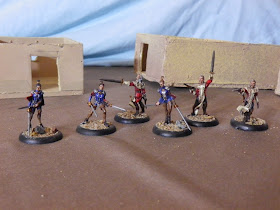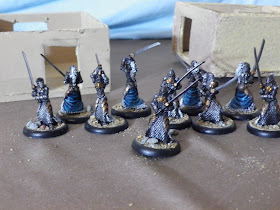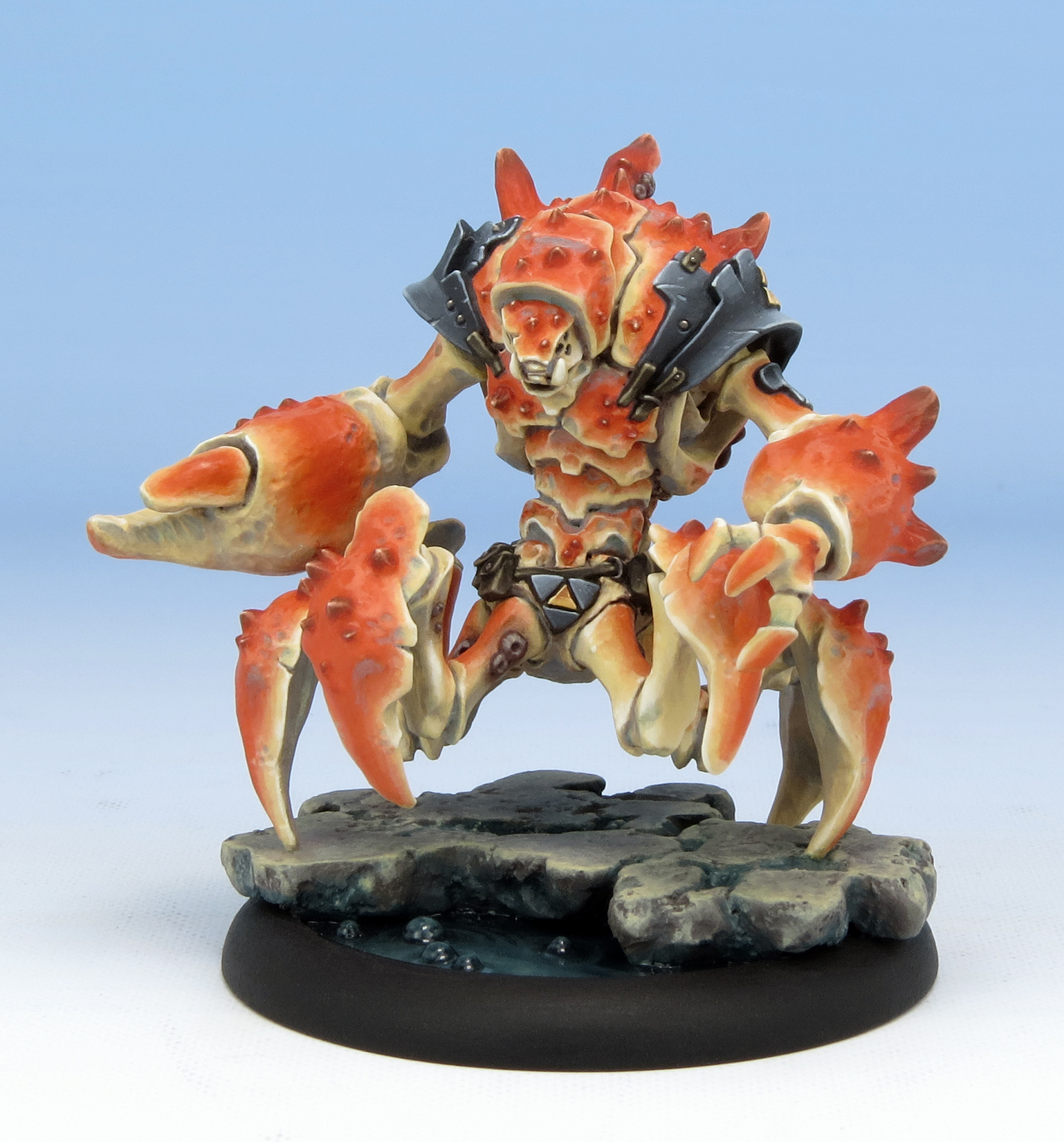I found a few rulebooks when cleaning my shed; generally I don't review anything I haven't playtested thoroughly but there's nothing about these two sets that I haven't seen before.
(Plus: they've been out for a while, so other reviews are available).
Accordingly, I'll start with
Broken Legions by Mark Latham. I was super excited about this when I heard of it: small skirmish campaigns where warbands of Roman special forces and barbarians battle over occult artifacts? Written by one of the
LoTR/Legends Of authors? Sign me up!
...So why does this rulebook lie abandoned?
Roman secret agents vs the occult... my imagination ran riot...
The Shiny
Broken Legions is attractively packaged softcover from Osprey. At about $15 posted it is priced
very well. It has a good mix of colour pictures and photos of miniatures in action. It's easy to read and clearly enough laid out. But... why did they chose such ugly minis? I don't know who the manufacturer is, but I looked to find out... so I never purchase any of the stunted little dwarfen things. Honestly, they killed my urge to collect a warband... I think the big problem is the rulebook, nice as it is, failed to "set the scene" very well. The occult-Roman setting (in theory) is amazing and full of potential - but the rulebook never "pulled me in" to its universe, nor did it even attempt to. I was left with
less interest in the setting then before I read the book.
Stats & Dice
Minis have usual stats - Melee, Accuracy, Physique
(a mix of Strength+Toughness, I use this in my own rules a lot), Agility, Presence
(basically Will); Wounds aka Hitpoints
(urk - hope this isn't common) and Fate
(basically a saving roll for heroes a la LoTR). Oh, and everyone moves 6".
RANT: Why the heck does every game nowdays make everyone move 6"?! Not only do you lose differentiation/tactics for a minuscule increase in complexity, but it makes no sense. I'm a PE/outdoor ed teacher, and the most obvious physical trait a person has is speed. If mobility/defence/offence are three key elements of combat; why ignore/abstract mobility so?
The dice resolution method is one I used myself (but later abandoned for reasons) in my homebrew rules; d10+stat to beat 10. A natural 1 is an autofail. However I am not a fan of the "critical dice" - this is an extra dice rolled alongside any attacks to check for crits; a roll of 10 on this extra dice means an auto-wound; and a 1 is a fumble (enemy gets extra attack in melee, or cannot shoot next turn if shooting)
. Whilst this sounds cinematic, it's just clunky
, and probably could be built into the dice roll without extra dice if it's so "necessary"
(see Song of Blades and Heroes, which can push back/knock down/kill/gruesomely kill without recourse to extra dice).
The illustrations were good, but the rulebook seemed bland; somehow it never "sucked me in" to the arcane world of Broken Legions despite the fact I wanted to "buy in"....
Activation
I quite liked this. Players take turns activating a mini each; players may shoot or move or charge or hide. Once all troops have acted; everyone melees, with the player with initiative deciding the order/arrangement of combat (rather like LoTR) which is something of a skill in itself. In fact, by making melee a separate phase, it sets itself apart from the usual alternate full activation of minis which is the "new standard" in wargames
(instead of IGOUGO which has mercifully died out).
Movement, Missiles, Melee
Yeah everyone moves 6"; they can test agility or move half speed (difficult going) or take a wound (dangerous going) and there's good, sensible rules for jumping gaps and vaulting obstacles.
Shooting is resolved by beating 10 with shooting stat+d10; with a reasonable amount of modifiers.
Melee is different: models take turns striking, in order of highest to lowest agility, it's a contested roll; melee skill+d10 with the attacker doing damage if he wins or having no effect if he loses. I'm not sure why each combatant needs separate rolls and why melee couldn't be made a single contested roll like LoTR or early 40k 2nd ed etc. The current method seems to double the amount of dice rolling, to gain little in return.
Oh, there's always the critical dice to roll alongside your normal dice when shooting/meleeing, to make things interesting (or waste time, depending on how you view it).
Doing damage is a contested roll: the shooting weapons have a "damage" rating + d10 to beat the target's Armour + d10, scoring one wound. Physical strength is not considered. In melee, the attacker's strength is a factor, but you have to consult a separate table for the modifier.
However my big gripe is
hitpoints. Multi-wound heroes aren't a big deal; but having the rank and file legionaries have two wounds is... poor design. It's unarguable that wound markers clutter the table. And wounds in Broken Legions don't
do anything (i.e. halve movement, or -1 to rolls, etc) besides make soldiers die slower. And if you merely want soldiers to die slower, simply modify the bloody damage rolls with a -1 or increase Armour to make soldiers tougher - or add a saving throw (after all, a rather meaningless "critical throw" was added; hmm, hang on - perhaps the critical throw was to mitigate all the multi-wound models... )
The extra dice rolls to resolve melee; the critical dice, and the proliferation of multi-wound models; all this seems like a step
back compared to the swift resolution of LoTR and its historical clones.
Morale
The usual. Well, your guys can take 75% casualties before they even need to
check to see if they run. Which seems frankly ridiculous and shows common sense/self preservation on the level of cheerleaders in a horror movie. I've
recently discussed it here, but honestly if you need 7 or 8 of 10 guys to die before the others think it maaaay be time to bail.... the last couple of guys have the self preservation of jihadi lemmings. The rules - which given the casualty tolerances may as well not exist - are otherwise standard, with units passing their
Will (sorry, "Presence") rolls or they break/flee etc pretty much as usual.
Fate & Heroic Actions
Fate (a saving throw for heroes) is cribbed straight from LoTR, and heroic actions seem pretty similar as well, albeit with much more variety and no "cost" beside missing an action. Actually I quite like Heroic Actions (not explored fully in LoTR, imo) and here you can direct massed archery to "bring down" a monster, challenge enemy heroes to duels, entreat the gods for extra Fate, boost allied morale, and have troops "follow on" or move/act with the leader (i.e. LoTR's heroic move).
The minis pictured in the rules were not appealing; some might label them "old school" or "characterful" - for me they were merely squat, malformed and ugly.
Magic (or "Miracles") & Special Abilities
These are pretty standard, but along with the stat "Presence" has triggered the following rant...
RANT: What the heck is with game authors renaming common stats just to confuse people? If your stat is and acts just like "Willpower" as used in a zillion other games don't rename it "Presence." If your magic spell causes enemies within range -1 to their Will Presence, and makes the caster Terrifying
, why do you need to call it something verbose like "Nightmare of Alu
" instead of "Fear
" or "Terror
" or something short and intuitive. Names should be simple, self explanatory and generic. If I have a spell that adds +1 to melee damage, does it make more sense to call it "Smite" or "Enscorcelled Ankh of Glowy Righteousness." I mean, what does "Dirge of Kotys" mean to you? If you want an example of how to do magic and special rules right, see Savage Worlds.
Anyway magic/miracles are cast by passing a
Will Presence roll, with a natural 1 losing a hitpoint of the caster and a 10 restoring a hitpoint previously lost. There are 20 spells (with annoying names) and 29 special rules (more mundanely named, which did not draw my ire) and about 30 rules specific to weapons and wargear.
Warbands and Campaign Rules
Broken Legions has, like every recent skirmish campaign game
(bar perhaps Frostgrave), completely missed the mark here. Remember how everyone is so nostalgic about
Mordhiem and
Necromunda? That's because of the gloriously complex campaigns, full of detail and drama. Like everyone else,
Broken Legions attempts to simplify the campaign bits; to the extent it is bland and boring. "Wound resolution" campaign rules are basically 5+ you live, 4 or less you die; herowounds are hardly more complex; "miss a game" "-1 physique next game" "perfectly fine."
Guys - it's
OK for
campaigns to be complicated! We've got time to record and do stuff
between games - it's
during games that recording and tracking stuff
(like wound markers, ahem!) is bad.
If the main point of your game is to be a campaign wargame that's about advancement, gaining XP, controlling territory, upgrading skills and weapons;
make it meaty! make it interesting! Don't just chuck in a few pages of half-assed stuff in the back of your book and call it a day. Likewise, 5 scenarios are fine for a wargame
(actually, I'd argue it isn't enough) but it's not enough for an engaging narrative campaign wargame. Have a look at
Malifaux if you want a good example; there are truckloads of missions, plus "side quests" (which can be revealed or hidden from your opponent) making dozens of permutations: mission variety is good, especially if a particular warband excels at a particular mission
(oh no, it's a "get the treasure off the board again" mission and my opponent has elves - might as well give up now).
Anyway, the campaign system is more in line with the simplicity of "
LoTR: Battle Companies" and has little in common with
Mordheim/Necromunda etc. The warbands are Romans, gladiators, barnarians, Dacians, Greeks, Parthians and Egyptians. They are accompanied by their various mythological/magic totems. Hydras, harpys, minotaurs, Amazons, skinchangers, druids etc; you can hire wandering heroes/monsters, and each warband has a "army list" showing how many of each unit and what extras they can carry. Very much
Legends of Roman Times as you were.
TL:DR
It's not an upgrade from
LoTR/Legends of the High Seas/Old West so much as a more (needlessly?) complicated "side grade." The barebones campaign and advancement system means it is
not a
Mordheim/Necromunda replacement. It's on a par with, say,
Empire of the Dead though at $15 it's hard not to recommend it. I just am left with a feeling of... disappointment? Andy Chambers must have been the inventive one back in the old days in GW, cos this has all the inventiveness of Rick Priestley's latest offerings. The rulebook was nicely presented (great for its cost) but fails to inspire; after I read it I was
less interested in the setting and decided
not to buy any warbands. Perhaps I'm overly harsh, but I'm sure there'll be plenty of
sycophantic gushing reviews by bigger blogs
who want more free review copies whose writers have had more coffee before sitting down to review.
Recommended? Yes. It's an OK rulebook, very attractively priced, and allows you to fight Romans legionaries against werewolves, druids and chimeras in a secret occult war. Besides a few annoyances (hitpoints boo hiss) it's an otherwise solid rules set which does what it says on the tin.




















































